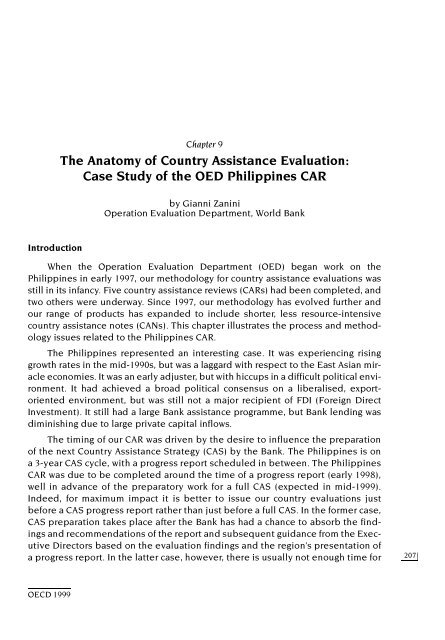Evaluating Country Programmes - OECD Online Bookshop
Evaluating Country Programmes - OECD Online Bookshop
Evaluating Country Programmes - OECD Online Bookshop
Create successful ePaper yourself
Turn your PDF publications into a flip-book with our unique Google optimized e-Paper software.
Introduction<br />
<strong>OECD</strong> 1999<br />
Chapter 9<br />
The Anatomy of <strong>Country</strong> Assistance Evaluation:<br />
Case Study of the OED Philippines CAR<br />
by Gianni Zanini<br />
Operation Evaluation Department, World Bank<br />
When the Operation Evaluation Department (OED) began work on the<br />
Philippines in early 1997, our methodology for country assistance evaluations was<br />
still in its infancy. Five country assistance reviews (CARs) had been completed, and<br />
two others were underway. Since 1997, our methodology has evolved further and<br />
our range of products has expanded to include shorter, less resource-intensive<br />
country assistance notes (CANs). This chapter illustrates the process and methodology<br />
issues related to the Philippines CAR.<br />
The Philippines represented an interesting case. It was experiencing rising<br />
growth rates in the mid-1990s, but was a laggard with respect to the East Asian miracle<br />
economies. It was an early adjuster, but with hiccups in a difficult political environment.<br />
It had achieved a broad political consensus on a liberalised, exportoriented<br />
environment, but was still not a major recipient of FDI (Foreign Direct<br />
Investment). It still had a large Bank assistance programme, but Bank lending was<br />
diminishing due to large private capital inflows.<br />
The timing of our CAR was driven by the desire to influence the preparation<br />
of the next <strong>Country</strong> Assistance Strategy (CAS) by the Bank. The Philippines is on<br />
a 3-year CAS cycle, with a progress report scheduled in between. The Philippines<br />
CAR was due to be completed around the time of a progress report (early 1998),<br />
well in advance of the preparatory work for a full CAS (expected in mid-1999).<br />
Indeed, for maximum impact it is better to issue our country evaluations just<br />
before a CAS progress report rather than just before a full CAS. In the former case,<br />
CAS preparation takes place after the Bank has had a chance to absorb the findings<br />
and recommendations of the report and subsequent guidance from the Executive<br />
Directors based on the evaluation findings and the region’s presentation of<br />
a progress report. In the latter case, however, there is usually not enough time for<br />
207

















![CQE=U]^\]Z: KAZAKHSTAN - OECD Online Bookshop](https://img.yumpu.com/3915768/1/190x253/cqeuz-kazakhstan-oecd-online-bookshop.jpg?quality=85)